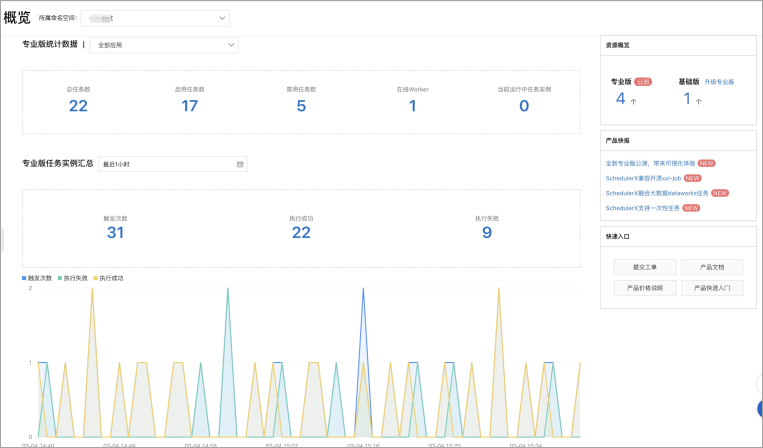阿里巴巴任务调度SchedulerX 2.0兼容开源ElasticJob任务接口,您无需修改代码,即可将ElasticJob任务在SchedulerX 2.0平台上进行托管。本文介绍在SchedulerX 2.0平台上托管ElasticJob任务的优势和方法。
背景信息
ElasticJob基于Quartz开发并且依赖ZooKeeper作为注册中心,是一款轻量级、无中心化的分布式任务调度框架,已在多家公司投入使用,目前已经通过Apache开源。更多信息,请参见ElasticJob。
SchedulerX 2.0优势
丰富的可视化能力
- 查看用户大盘

- 查看任务历史记录

- 查看用户运行日志

- 查看任务运行堆栈

- 查看任务操作记录

高级特性
- 任务编排支持工作流(DAG)进行任务编排,可通过拖拽对前端进行操作。详细的任务状态图方便您一目了然地看到下游任务为什么没有执行。

- 限流
常见场景是夜间离线报表业务,比如很多报表任务是凌晨1点或者2点开始,要控制应用最大并发的任务数量(否则业务无法支撑),达到并发上限的任务会在队列中等待。同时要求早上9点前必须完成KPI报表,可以设置KPI任务高优先级,会抢占低优先级任务优先调度。
SchedulerX 2. 0支持可抢占的任务优先级队列,只需要在控制台进行配置即可。

- 资源隔离
支持命名空间和应用级别资源隔离,支持多租户权限管理。
商业化报警运维
- 报警
支持通过邮件、钉钉、短信或电话进行任务执行失败、超时和无可用机器报警通知。
- 运维操作
支持原地程序运行、重刷数据、标记成功、查看堆栈、停止任务和指定机器等。
免运维、低成本
ElasticJob依赖ZooKeeper作为任务存储和任务调度协调,至少需要3个节点的ZooKeeper。如果有节点发生故障,需要重新配置ZooKeeper的服务端和客户端的配置,可能需要重启所有的应用。同时,受ZooKeeper功能限制,如果任务量级比较大,一个ZooKeeper集群将无法支撑住,且ZooKeeper无法水平扩展支持更大的TPS,就需要维护多个ZooKeeper集群,这样会增加机器成本。
通过SchedulerX 2.0托管ElasticJob任务,您不需要自己维护ZooKeeper集群,也不需要关注任务量级的增长,节省了机器和人力的维护成本。
高可用
SchedulerX 2.0采用高可用架构,任务多备份机制,经历阿里集团多年双十一、容灾演练,可以做到整个集群任意2个节点发生故障或者任意一个机房断电,任务调度都不会受到影响。
与开源ElasticJob的区别
| 对比项 | 开源ElasticJob | SchedulerX为底座的ElasticJob任务 |
| Simple任务 | 支持 | 支持 |
| Script任务 | 支持 | 支持 |
| Dataflow任务 | 支持 | 支持 |
| 单机 | 支持 | 支持 |
| 分片广播 | 支持 | 支持 |
| 定时 | cron | cron、fixed_rate、fixed_delay、one_time |
| 工作流 | 不支持 | 支持 |
| 可视化 | 无 | 历史记录、日志服务、运行堆栈、操作记录、用户大盘等 |
| 监控报警 | 邮件 | 邮件、钉钉群、短信、电话 |
| 运维操作 | 无 | 运行一次、原地重跑、重刷数据、标记成功、停止运行 |
Spring Boot接入方法
以ElasticJob-3.0.1版本为例,更多信息,请参见Demo工程。
- pom.xml文件增加schedulerx2-plugin-elasticjob插件,删除elasticjob-simple-executor和elasticjob-dataflow-executor,删除后如下所示:
<!-- elasticjob --> <dependency> <groupId>org.apache.shardingsphere.elasticjob</groupId> <artifactId>elasticjob-lite-spring-boot-starter</artifactId> <version>3.0.1</version> <exclusions> <exclusion> <groupId>org.apache.shardingsphere.elasticjob</groupId> <artifactId>elasticjob-simple-executor</artifactId> </exclusion> <exclusion> <groupId>org.springframework.boot</groupId> <artifactId>spring-boot-starter-logging</artifactId> </exclusion> <exclusion> <groupId>org.apache.shardingsphere.elasticjob</groupId> <artifactId>elasticjob-dataflow-executor</artifactId> </exclusion> </exclusions> </dependency> <dependency> <groupId>com.aliyun.schedulerx</groupId> <artifactId>schedulerx2-plugin-elasticjob</artifactId> <version>3.0.1.3</version> </dependency> - 在SchedulerX控制台创建您的命名空间和应用。具体操作,请参见创建命名空间和应用管理。
- 修改application.yml原有的ElasticJob配置。
elasticjob: regCenter: serverLists: localhost:2181 namespace: elasticjob-springboot-demo schedulerx: #这里需要增加一个"schedulerx:",则如下任务会自动同步到SchedulerX控制台。 jobs: simpleJob: elasticJobClass: com.alibaba.schedulerx.example.elasticjob.job.MySimpleJob cron: 0/30 * * * * ? shardingTotalCount: 1 overwrite: true shardingJob: elasticJobClass: com.alibaba.schedulerx.example.elasticjob.job.MyShardingJob cron: 0 * * * * ? shardingTotalCount: 3 shardingItemParameters: 0=Beijing,1=Shanghai,2=Guangzhou overwrite: true dataflowJob: elasticJobClass: com.alibaba.schedulerx.example.elasticjob.job.MyDataFlowJob cron: 0 * * * * ? shardingTotalCount: 3 shardingItemParameters: 0=Beijing,1=Shanghai,2=Guangzhou props.streaming.process: true #开启流式处理。 overwrite: true #增加如下SchedulerX的配置。具体操作,请参见Spring Boot应用接入SchedulerX。 spring: schedulerx2: endpoint: acm.aliyun.com namespace: 433d8b23-xxxx-xxxx-xxxx-90d4d1b9a4af groupId: elasticjob-test appKey: xxxxxxxxxxx regionId: public aliyunAccessKey: xxxxxxxxxxxx aliyunSecretKey: xxxxxxxxxxxx - 启动程序增加自动扫描com.alibaba.schedulerx.plugin.*。

- 配置日志服务,搜集客户端的日志。使用log4j2配置log4j2.xml。具体操作,请参见阿里巴巴任务调度SchedulerX支持日志服务。
<?xml version="1.0" encoding="UTF-8"?> <Configuration status="off"> <Appenders> <Console name="Console" target="SYSTEM_OUT"> <PatternLayout pattern="%d{yyyy-MM-dd HH:mm:ss.SSS} [%t] %-5level %logger{36} - %m%n" /> </Console> <SchedulerxLog4j2Appender name="schedulerxLog" timeFormat="yyyy-MM-dd'T'HH:mmZ" timeZone="UTC" ignoreExceptions="true"> <PatternLayout pattern="%d %-5level [%thread] %logger{0}: %msg"/> </SchedulerxLog4j2Appender> </Appenders> <Loggers> <Root level="info"> <AppenderRef ref="Console" /> </Root> <Logger name="schedulerx" level="info" additivity="false"> <AppenderRef ref="schedulerxLog" /> </Logger> </Loggers> </Configuration> - (可选)如果您需要采集业务日志,可以使用原生log4j2/logback打印日志。无需修改任务实现逻辑。
@Component public class MySimpleJob implements SimpleJob { private static final Logger LOGGER = LogManager.getLogger("schedulerx"); @Autowired private HelloService helloService; @Override public void execute(ShardingContext context) { LOGGER.info("jobName:" + context.getJobName() + ", hello:" + helloService.hello()); } } - 启动程序,SchedulerX控制台将自动同步任务。重要
- 其中调度频率为秒级别,时间类型会改为second_delay。
- 分片个数大于1时,执行方式为分片运行,否则是单机运行。
通过控制台可以看到任务的运行日志。
